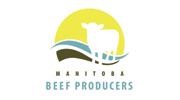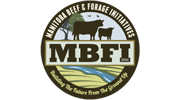Evaluating forage species for stockpiled forages
| Project Code: | FRG.14.13 |
| Completed: | March 2018 |
Project Title:
Building long-term capacity for resilient cow-calf production systems through creation of a forage industry chair supporting training and research in evaluation and utilization
Researchers:
Emma McGeough, Ph.D., Karin Wittenberg, Ph.D. and Paul Jefferson, Ph.D. Emma.Mcgeough@umanitoba.ca
Emma McGeough, Ph.D., Karin Wittenberg, Ph.D. (University of Manitoba), Paul Jefferson, Ph.D. (Western Beef Development Centre), Kim Ominski, Ph.D., and Derek Brewin (University of Manitoba) Bruce Coulman, Ph.D. (University of Saskatchewan), Kathy Larson (Western Beef Development Centre), Jennilee Bernier and Glenn Friesen (Manitoba Agriculture, Food and Rural Initiatives), Leanne Thompson (SK Forage Council), Corie Arbuckle (MB Forage Producers) and Manitoba Beef Producers
Background:
In Canada, the acreage dedicated to forage and pasture production has diminished with increased competition from annual crops for human and animal consumption. Therefore cattle producers have faced increased reliance on marginal lands to meet their forage needs. In order to remain sustainable and competitive, they continue to seek new avenues for extending the length of the grazing season and decrease the cost of winter feeding. It is clear that research is required to identify superior strategies for extended grazing to improve animal performance under the range of soil and weather conditions observed in the prairie provinces. Stockpiling can refer to forage accumulation from spring regrowth or following grazing or haying during the growing season. Forages that maintain production and persistence of quality during frost and snow are desirable in these pasture-based systems. This study includes examination of the impact of forage quality in fall/winter on animal performance, grazing behaviour, feed intake and energetic efficiency.
Objectives:
1) Evaluate annual and perennial forage species for their potential as stockpiled forages for overwintered beef cattle
2) Evaluate beef heifer performance, feed intake, energetics and grazing behaviour during stockpiled forage grazing in late fall/early winter
3) Evaluate the economic impact and risk analysis of stockpiled perennial and annual forages in overwintering systems
What they did:
Following consultation with the joint Manitoba-Saskatchewan industry-led steering committee, a variety of perennial and annual forages were selected for assessment based on potential suitability for extended grazing, accessibility and cost.
In a small plot research trial, annual and perennial forages chosen were; oats (Haymaker), barley (Maverick), corn (Fusion), soybeans (Mammoth), foxtail millet (Golden German), fall rye (Hazlet) and annual rye (Westerwold). Perennial forages were seeded in pure and mixed stands with five grasses (tall fescue (Courtney), orchardgrass (Killarney), meadowbrome (Fleet, Success, Armada)), three legumes (Alfalfa, Algonquin and Yellowhead) and cicer milkvetch (Oxley II), providing 23 perennial treatments for comparison. Perennial stands were also managed for early (mid-June) or late (Mid-late July) forage stockpiling. This research was carried out at five sites across Manitoba and Saskatchewan providing data under a range of soil and climatic conditions.
Following assessment of a range of these forages, four treatments were chosen for a stockpile grazing trial involving bred beef heifers at Brandon, Manitoba. Forage treatments were: 1) tall fescue/meadowbrome, 2) orchard grass/Algonquin alfalfa, 3) tall fescue/Algonquin alfalfa/cicer milkvetch and 4) corn. Animal measurements were conducted from early October to mid-December and included performance, feed intake, enteric methane emissions and grazing behavior.
What they learned:
In the small plot perennial forage analysis researchers found that fall yields for late stockpiled forage were less than 2000 kg/ha, the desirable amount of available standing forage for winter grazing. Below this amount, grazing efficiency decreases, particularly under snow conditions when access to available forage may be limited with early stockpiling, grass and grass plus legume mixtures had higher fall yields than pure legume stands. Among the grass mixtures, tall fescue mixtures with either alfalfa cultivars or with milkvetch had the highest yields, with pure stands of tall fescue next, supporting the role of tall fescue in extended grazing systems. The crude protein levels for pure grass stands were low when compared to the pure legume stands but the crude protein levels in mixtures were acceptable or even high for dry cows. Annual forage analysis indicated that fall rye and soybean had the highest protein concentration but the lowest dry matter yield. Of all of the crops used, corn had the highest energy content and fall rye had the highest protein content but the latter also had the lowest yields.
In the grazing study, researchers observed that although the nutrient profile of the forage treatments differed, there were no significant differences in animal weight between the treatments confirming the potential use of these species for stockpile grazing systems. All animals lost weight by the end of the second period when temperatures fell, suggesting strategies to decrease energy expenditure (wind fences) or increase nutrient intake (supplement) may be required during periods of inclement weather. Heifers that grazed corn spent less time at the wind shelter than those grazing perennial forage treatments.
What it means:
For several forage quality attributes, grass mixtures with cicer milkvetch were rated as better quality. This suggests that tall fescue with milkvetch may be the most promising grass/legume combination for extended grazing in the prairie region. Assessment of annual forages showed that corn offered protection during inclement weather, however this did not result in increased weight gain indicating the low forage crude protein did not support higher levels of performance despite the benefit of the shelter it provided.










